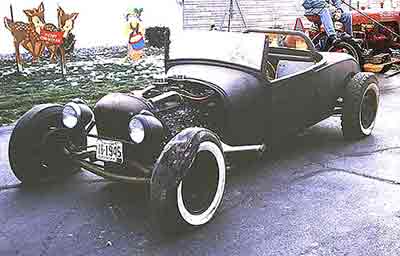
As pulled out of the shed after 40+ years with '34 truck grill in place
The Shell Game
Deuce (as in two, not Thirty-Two) Grill Shells
The ’32 Ford grill shell is an interesting piece of American industrial art. What is it about its subtle curves that evokes a strong, though less than rational, response from all who love cars? It’s not particularly streamlined. In fact, next to the swoopy ‘33/34 grills, it’s positively box-like and only vaguely smoothed over from its Model A predecessor. So what is it that gives it its ability to totally change the way you look at an old car?
Somewhere in its subtle combination of curves is a visual language that sometimes whispers, at other times shouts, the word “hotrod.” As American as jazz, the hotrod almost always hits its high notes with a deuce grill shell playing lead.
Even though only 15 years old at the time, I had to have a deuce grill shell if I was going to build my magazine hotrod. That was a given. However, like everything else in the tale of this small town street roadster, it wasn’t quite that simple. Actually, getting the grill shell WAS simple. Embarrassingly simple. It got complicated after that.

As pulled out of the shed after 40+ years with '34 truck grill in place
When I’d make my pilgrimages on the bus to Lincoln to haunt young Bill Smith’s little storefront speed shop, Speedway Motors (yes, that, Speedway Motors), I was always looking for something “hotroddish” that I could afford. I seldom found anything. But sometimes I did. In fact on one trip I hit the mother lode.
For a year or two, my cousin, Bobby Mercer, later to be a used car king of huge proportions, worked behind the counter at Speedway. Bob was much older than me but we’d always been fairly close and he got a kick out of my interest in cars and hotrods.
On this one particular trip, I leaned over the glass counter and there, hanging on the wall in the corner, was a’32 Ford grill shell, complete with grill insert. It was perfect with not a dent or a bent bar. Perfect! And I wanted it badly.
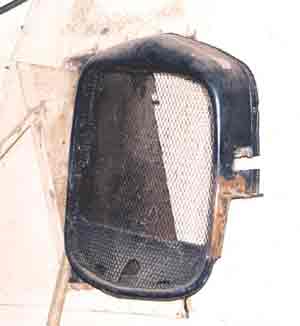 |
V-8 with only six exhaust ports and then snake the exhaust out through the block like a gopher looking for the front door, he set-up a ready made overheating problem.
There were probably some radiators that would have worked, but I already had a ’40 Ford radiator (don’t ask me where I got it or I’ll have to tell you about cutting up a perfectly good ’40 tudor and make you cry). I knew the ’40 radiator would cool the engine but it was so tall that I had to drop it down between the frame rails behind the tie rod to make it fit the lines of the car. That put it about six inches behind the axle with about only a half-inch between it and the distributor. Bottom line? I couldn’t get the Deuce grill shell close enough to the radiator to look good, but I was sure as hell going to try. When a kid has a ’32 grill shell he isn’t going to leave it sitting in the shop—words soon to be eaten.
With the radiator so far back, I had to try to push the grill shell as far back as I could. By the time I tried to mount it, I already had the suspension in the car and a super crude pair of head light stands with a square tubing crossbar between them. I hacksawed a rough square out of each side of the grill shell and pushed it as far back as it would go, which included bending the sides at the bottom with a pair of vice grips to clear the axle. There was still a big gap between the radiator and the grill shell and it looked like crap, but I was going to soldier on.
And then came the chopping scenario. I’d laugh about this if it weren’t so grim.
With the nose of the car in the dirt, the radiator shell was obviously entirely too tall. The cure? Chop it like the big guys do, right? No big deal. In a new-millennium post mortem of the butchered shell I was glad to see I had at least used a hacksaw and not the torch on it. I was not glad to see how much too short it was for the reincarnated roadster with its un-Z’d frame. No matter—where I had chopped it was so low in the curve of the sides that when the two halves came back together the pieces didn’t match and were a solid eight of an inch out of whack. Pretty ugly, Budd!
The only smart thing I did I did in the entire venture was to leave the pristine grill insert alone. Even at that age, it was so perfect, I couldn’t bring myself to cut it up and it hibernated in a downstairs closet of my folks’ house for forty-some years until I gave it to Lowell Krueger while he was doing the body work in 2001. He had a ’32 shell with no insert so it seemed only right that he have it. As a kid, I cut some reinforcing screen of some sort into the right shape and used that for a grill insert.
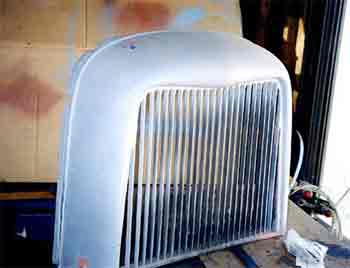 |
 |
When it came to the grill insert, I thought long and hard about it. Do I go through the brain damage of trying to make one or modify a repro? To make one was going to be a real chore and I spent a lot of time investigating different suppliers looking for the bars, which I didn’t have a clue how I would make. In the end, I gave up and called the guys at Speedway.
I had purposely planned on sizing the grill shell so it would take one of the four and a half inch chopped grill inserts that were readily available in case I got desperate. But the very concept of using a repro grill insert stuck in my craw like a tumbleweed. As it turns out, Speedway had a full-length insert that had been damaged in shipping and would make me a helluva deal on it. Okay, that would work. It was a long way from being usable, as is, and I’d still have to chop it, so I wasn’t exactly copping to the repro thing. The ability to rationalize your way out of a lot of work is a wonderful thing.
When the insert showed up I realized what a huge task this was going to be, but the die had been cast. I gingerly pulled all the bars out of it and proceeded to remove three and a half inches out of each side. This required a lot of screwing around to make sure it was straight and then I had to do some shrinking on one side to get it square and flush at the bottom. Then it was time to tackle the grill itself.
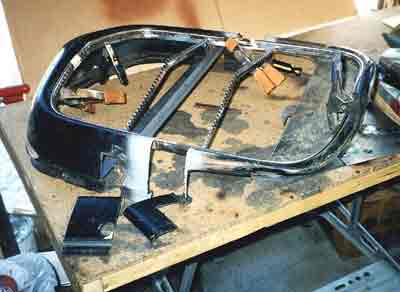 |
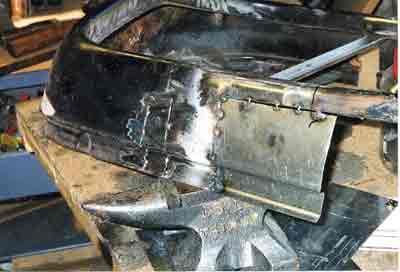 |
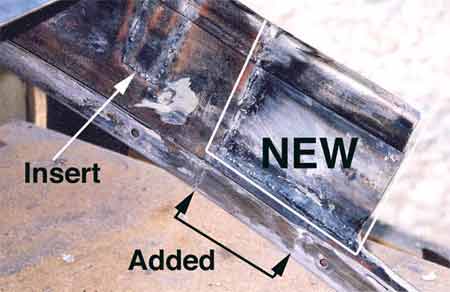 |
 |
It was about this time that I decided to remove the paint from the shell and when I did, I got a fateful surprise: when I had filled the radiator fill hole at the top as a kid I had done it with lead, not plastic. Zowie! I hadn’t realized I’d been using lead when I was that young although I used plenty of it later.
This discovery started another of those “…as it was done originally” thought patterns. If I was using lead at 15/16 years-old, I could sure as hell do it now. However, not a body supply store in town had it on the shelf (gee, I’m surprised, aren’t you?) so I had to order it.
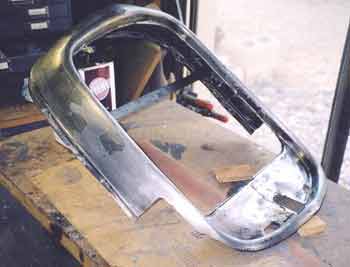 |
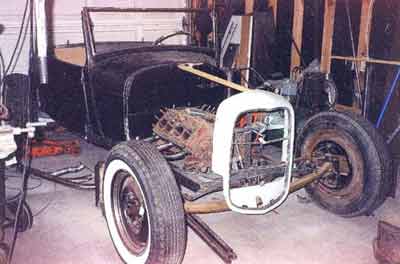
Now that's how a roadster is supposed to look! The radiator will sit on top of the cross member and will still stick out of the back of the shell, but it'll be touching the shell and, with the proper shroud should look okay. I hope the great gods of authenticity will forgive me but, the reality of driving a flathead in Arizona with a short radiator, means I'm going to run an aluminum radiator, with an electric fan in front. Ain't no such thing as too cool in AZ.
At this stage of the game I have only chopped the outer frame of the insert, which told me multitudes about ’32 grills and what makes them what they are. For instance, they aren’t the same width at the top that they are at the bottom. They taper ever so slightly and this is what keeps them from looking blocky. It’s also what makes them so subtle and artful. It also means that chopping them requires a lot of forethought so the pieces come back together with the same dimensions. I had done none of that thinking the first time around but I sure as hell did this time.
I’ll get into chopping and inserting the bars in the grill insert at a later date because it gives me a headache to think about it now.
Later, dude.